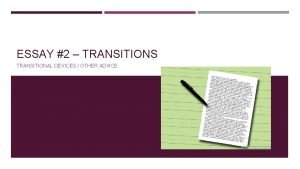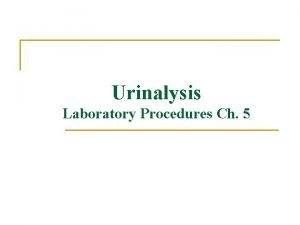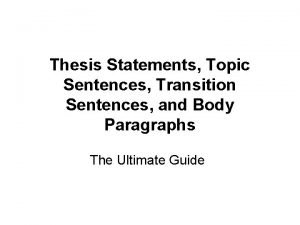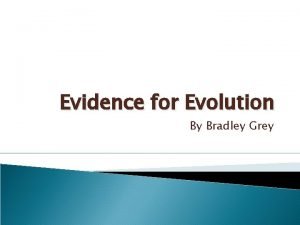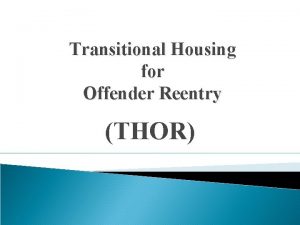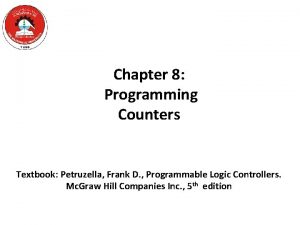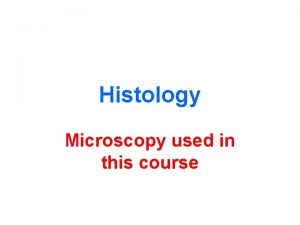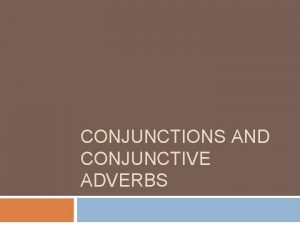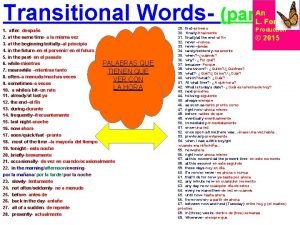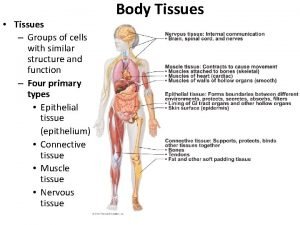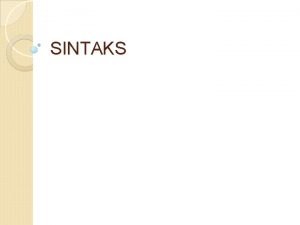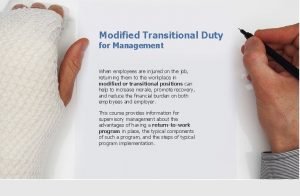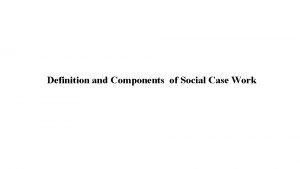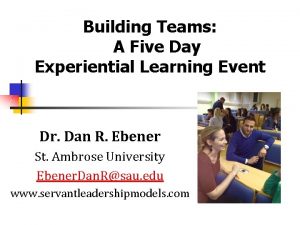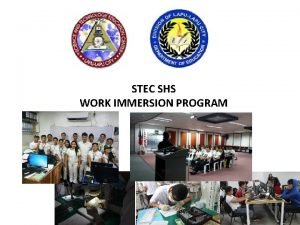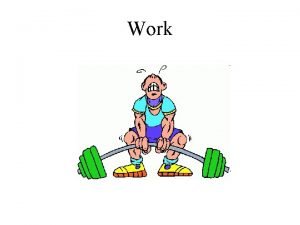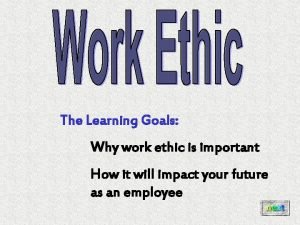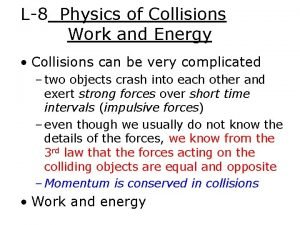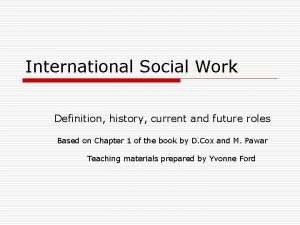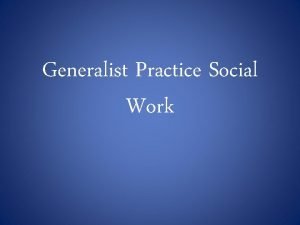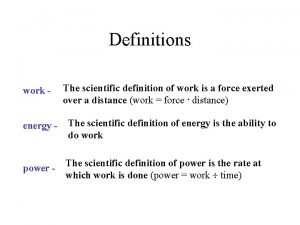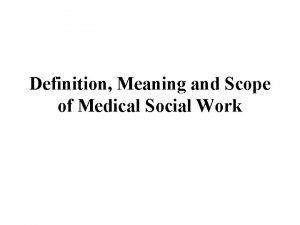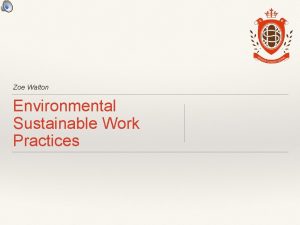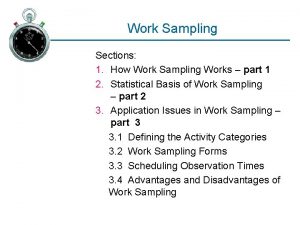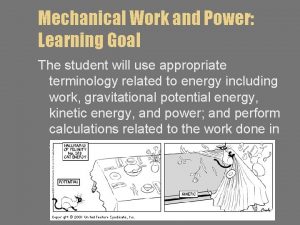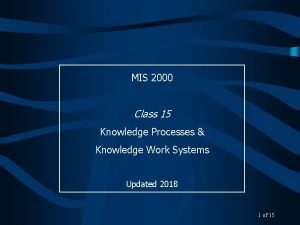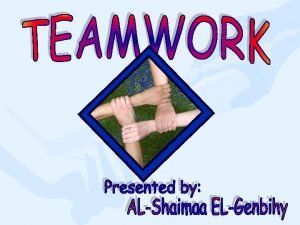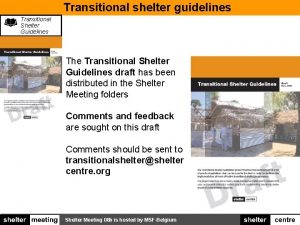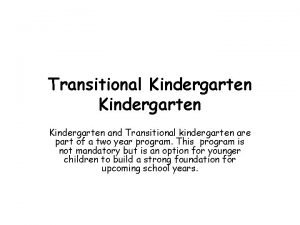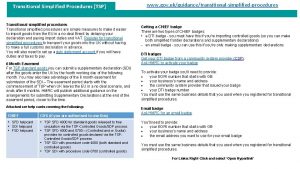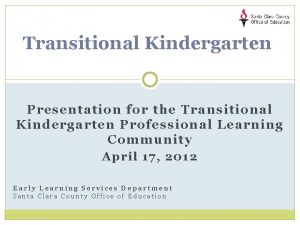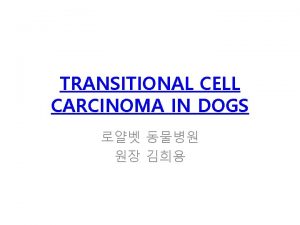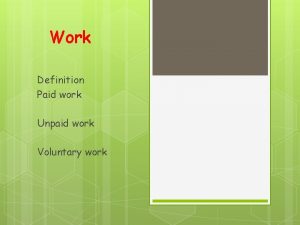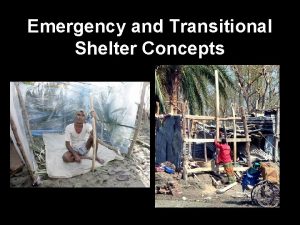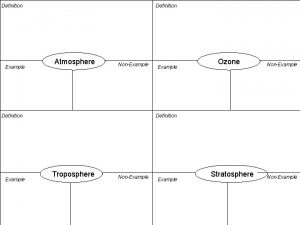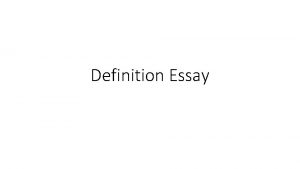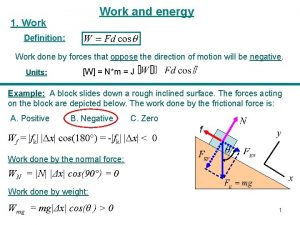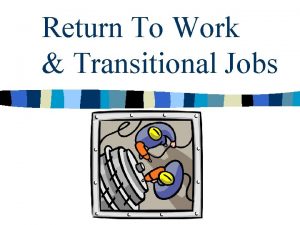Transitional Work n Definition of Transitional Work TW




































































- Slides: 68

Transitional Work n Definition of Transitional Work (TW) n Difference between TW and Light Duty n Steps to Setting Up a Transitional Work Program n Cost Impact of Transitional Work n Benefits of Transitional Work

What is Transitional Work? Transitional work is any job, task, function or combination of tasks or functions that a worker with restrictions may perform safely, for remuneration and without the risk of re-injury.

Another Definition Transitional work is a progressive and individualized Program. It is an interim step in the physical conditioning and recovery of a worker with restrictions towards the goal of returning to the original job. Transitional work represents the opportunity for the employer to protect the employability of a worker with restrictions while reducing the financial liability associated with work restrictions and lost time.

Transitional Work Program n Returns the worker with physical restrictions to the original employment site. n A progressive, individualized, time-limited program. n Allows the injured worker to perform productive work at the workplace.

Transitional Work Program n The program may include progressive conditioning, on-site work activities, and education for safe work practices. n The program could include job modification or alternative work assignments.

Light Duty Transitional Work n Light duty is opened ended n Transitional work has a starting and ending date n No therapeutic goals defined n Offers work hardening or otherapeutic benefits

Light Duty n n Transitional Work n Responsibilities are clearly defined in writing n Alternative plan will be developed Responsibilities of employer or employee are not outlined No alternative plan if light duty fails

Philosophy needed n Buy-in by top management n Labor involvement n Commitment for openness n Confidentiality n Policy has to be logical and fair to all

Steps to Setting Up a TWP Set up a committee n Develop a written program n Create action steps n Communicate/train employee & supervisor(s) n Implement program n Evaluate program continuously n

Members of the Committee • Management • Labor • Payroll and benefits • Human resource • Disability management expert

Members of the Committee continued • Training • Union representative • EEO representative • RTW Coordinator • Common Sense Person

Develop a Written Program Establish mission statement n Determine how disputes will be resolved n Identify how the program will be evaluated n Determine alternative procedures if problems arise n

Develop a Written Program continued n Define roles and functions of Committee members Identify eligibility for participating in the program n Establish time limits n

Transitional Work Program Components Job Analysis n Functional Capacity Evaluation n Therapeutic Intervention n Work Task Progression n

Getting Started: Job Analysis PT or OT goes to the work site to evaluate physical demands of the original or targeted job. n May require analysis of “IN-BETWEEN” jobs for progression. n Identifies productive and safe light duty options and a plan for progression to full duty. n

Getting Started: Functional Capacity Evaluation ( FCE ) Determines the workers ability to lift, sit, stand, bend, stoop, and perform jobrelated tasks. n Identifies barriers to full duty work, problems requiring treatment. n

The Program: Therapeutic Intervention n TW Program may include on site therapy services such as: – Exercise instruction to resolve identified problem areas and improve strength, endurance and function. – May include manual treatment to improve mobility / flexibility or decrease pain to assist job performance.

The Program: Work Task Progression Job demands are gradually increased using jobs available or modifying job tasks. n May include periods of regular job performance intermixed with light duty tasks. n Teach techniques of injury prevention, proper body mechanics, and promote positive work behaviors. n

Strategies Used by Therapists Pacing n Body Mechanics Training n Exercises n Manual Therapy n Progressive Work Tasks n

Benefits 25 to 35% savings n Better Morale n Loyalty to Company n Eliminate Hidden Costs n Quality/Production n

Other Benefits Disability Management for Workers Injured on and off the job n ADA Compliance n Ergonomic Improvements n Increased Safety n

Cost Impact of Transitional Work Reduce payment of lost-time compensation • Direct impact on reserves • Indirect impact on premiums • • Helps improve your safety and financial goals Win /win for employer and employee

Direct Cost vs. Indirect Cost Is Four Times the Direct Cost

Direct vs. Indirect Costs • Medical costs • Hiring replacements • Compensation costs or (insured costs) • Training replacements • BWC claim reserves • Legal expenses • Overtime (lost work) • Product/tool damage • Production delays • Loss of business (customer good will)

Indirect Costs are 4 times your company’s BWC Insured Direct Costs Medical & Compensation Costs $1, 500. 00 Compensation Reserve $3, 500. 00 Total Insured Cost $5, 000. 00 Total Insured (direct costs) X (indirect costs) = $5, 000. 00 X 4 = $20, 000. 00 Total Insured (direct costs) + (indirect costs) = $5, 000. 00 + $20, 000 = $25, 000. 00

Profitability and Your Bottom Line n n n Direct Costs total $5, 000. 00 Direct Costs + Indirect Costs Total $25, 000. 00 Your company’s Profit Margin is 5% from sales Your company’s Sales Department must generate: $500, 0000. 00 to compensate for this loss 1% Company Profit Margin = $2, 500, 000. 00 2% Company Profit Margin = $1, 250, 000. 00

Benefits to the Injured Worker Tends to recover more quickly n Participates in a work activity as soon as he/she is able n Experiences a smoother transition back to regular duty n Feels improved self-esteem in spite of medical condition n

Benefits to the Injured Worker Receives a full, regular paycheck n Maintains relationships with co-workers and management n Reinforces management’s commitment to employee welfare n

Transitional Work. GRANT$

Transitional Work Developer Criteria § § § Credentials as one of the following CRC, CDMS, CCM, CVE, COHN, OT, PT. Verified experience in developing transitional work programs. Completed BWC-sponsored transitional work development orientation. BWC Transitional Work Certification must be renewed every two years. Current workers’ compensation coverage.

Transitional Work Program Basic Elements n Corporate analysis n Employer/employee negotiations n Policy / Procedure n Functional job analyses n Program evaluation mechanism

Transitional Work Program Development n Agreement is between employer and developer. n. Transitional work program developer , employer, & labor work together to create a customized, employer-specific transitional work program.

REIMBURSEMENT Base rate between $ 1000 to $2400 n $ 160. 00 per job analysis maximum 20 n 3 maximum number of grants n All reimbursements based on number of employees n

The Future is Transitional Work n QUESTIONS ?

Remain at Work Program

Goal of Remain at Work To assist injured workers in remaining at work by providing services to injured workers with Medical Only Claims that are experiencing difficulties.

Eligibility § Injured Worker has an Allowed or Certified Medical Only Claim. § Injured Worker is experiencing difficulty at work due to the allowed condition. § The employer, injured worker or physician has identified the difficulty.

Lost Time Changeovers n Injured Worker is no longer eligible for Remain at Work Services, once claim becomes Lost Time. n Remain at Work Services are to cease immediately upon changeover to Lost Time, (exception C 92 awards).

RAW Billing n All RAW services will be charged to the Risk. n Employer provided services will not be reimbursed, (GRTW, OJT).

Rehab Services n n RAW Services not resulting in a RTW Lost Time Claims

Lost Time Claim Non-medical factors complicating a return to work: n Emotional n Vocational n Social n Economic Factors

Example for Lost Time n Refer to BWC or MCO. n MCO assigns case manager. n Case manager contacts employee, physician of record and the employer.

Example for Lost Time continued n Case manager writes an individualized plan, coordinates plan with all parties. n Employee returns to work in original job with full or modified duties, or a different job with same employer.

Rehabilitation Services n Case Management n Physical Reconditioning n Living Maintenance n Onsite Transitional Work n Job Analysis n Vocational evaluations

Rehab Services n Pain & stress programs n Work hardening n Job Modification n Employer incentive contracts

GRTW Payment Through BWC n GRTW pays for restricted hours at hourly rate not to exceed living maintenance rate n Example: 20 hours restricted x $10. 00 hourly rate = $200. 00 amount to be paid as LM rate. Employer will pay hourly rate for hours actually worked.

GRTW Employer Reimbursement n The employer may elect to pay full wages and be reimbursed up to 50% of wages paid to the employee through a rehab plan. n The employer incentive contract must be signed by all parties before program is implemented.

Integrating Transitional Work and Rehab

History: Case #1 Name: Mr. Herbie. n DOI: 02 -11 -2003 n MOI: Attempting to clear press from jam n DX: Amputation of right thumb of dominant hand n

History - continued Client off work from date of injury (Feb. 11, 2003) n Treated with medications and rest n Received outpatient physical therapy n Was placed in a rehab plan for a TWP n

TWP Evaluation Process: Job Site Analysis – Critical Job Demands n Musculoskeletal Evaluation – Restrictions/Barriers to RTW – Functional Capacities n Treatment Plan n

Critical Job Demands: Medium-Heavy Strength Range Set up press (change die) pushes into place. Use hand tools to tighten/ loosen die n Perform coil change out. n Operate Press, operates various hand controls uses hand tongs to place part into press n

Critical Job Demands: Medium-Heavy Strength Range n Use air gun to remove scrap and /or push stick to remove scrap or jams n Load product (door hinges) into bins n Perform quality checks every hour n Keep work area clean

Musculoskeletal Evaluation: Assessment: n Decreased wrist/hand ROM n Hypersensitive to light touch along the amputation site n Decrease grip and pinch strength n

Musculoskeletal Evaluation: Decreased wrist/hand strength n Decreased protective sensation at the amputation site n Limited fine motor functional use n

Physical Capacities Lift 5 pounds with both hands floor to overhead and carry 30 feet. n Unable to lift more than 1 pound with dominant hand n Push with 30 pounds force n

Physical Capacities Pull with 10 pounds of force n Uses fingers to make fist n Uses palm to push n Does not grip handle n

Barriers to Full Duty Decreased grip/pinch strength n Loss of thumb effects material handling n Decreased fine motor n Decreased protective sensation n Hypersensitivity at amputation n Decreased strength/ ROM n

Goals to Address Barriers n Therapeutic exercise n Work task modification n Work task progression.

Treatment Plan: Transitional Work Services 2 -3 times a week n Desensitization activities n Manual therapy (mobilization stretching, strengthening exercises n Work task Modification n Work task progression. n

Work Task Progression: Week 1 n Work on press only w/an assistant n Progress length of time operating press n Limit work on press to 1 -2 hours a day n Assist co worker with quality checks, load material into bins n Do not perform coil change out die change n

Work Task n Week 2 • Improve tolerance and ability when working with co-worker • Work half day with co-worker half independently • Load material into bins • Use air gun and push stick independently • Assist with die change • Modified tools maybe used

Work Task n Wk. 3 n Work on press independently 4 hours in a row Assist in die change( use of tools, levers to tighten/loosen) Assist with coil change (push pull coil into place) n n

Work Task n Wk. 4 n Safely operate press 8 hours a day without assistance Perform die change with infrequent assistance Perform coil change out independently n n

Treatment Summary: DOI: Feb. 11, 2003 n RTW restricted duty: June 11, 2003 n Treatments within the Transitional Work Program from June 11, 2003, to July 11, 2003. n RTW Full Duty: Monday, July 14, 2003 n n Total Cost of TWP: $2, 520 (14 treatments @ $180. 00)

Case Summary n n n n n CS #1: press operator Amputation of thumb Off work: 4 months Total cost of claim: Indem. $ 10, 304. 00 Medical 8, 000. 00 Scheduled Loss 38, 640. 00 Reserve 200, 000. 00 Total $ 256, 644. 00

If not able to maintain employment with the original employer n Career Exploration n Job seeking skills training n Training (enhancement/formal) n Job search

Nothing great was ever achieved without ENTHUSIASM! Ralph Waldo Emerson
 What are transitional devices
What are transitional devices Wbc cast
Wbc cast Transition word for thesis statement
Transition word for thesis statement Transitional words
Transitional words Transitional fossils
Transitional fossils Holocrine
Holocrine Transitional housing for offender reentry
Transitional housing for offender reentry Transitional signals
Transitional signals Kinetic chain checkpoints
Kinetic chain checkpoints Dynamic postural assessment overhead squat
Dynamic postural assessment overhead squat Stratified columnar
Stratified columnar Design elements hair
Design elements hair Simple cuboidal epithelium
Simple cuboidal epithelium Transitional medical assistance ohio
Transitional medical assistance ohio Evolution fact or fiction
Evolution fact or fiction Transitional epithelium
Transitional epithelium Apical side of epithelial cells
Apical side of epithelial cells Aquatic areas
Aquatic areas A one-shot, or transitional, contact:
A one-shot, or transitional, contact: Torrance memorial medical center medical records
Torrance memorial medical center medical records Simple cuboidal epithelium
Simple cuboidal epithelium Transitional adverbs list
Transitional adverbs list Transitional expressions
Transitional expressions Transitional expressions
Transitional expressions Similar pics
Similar pics What tissue is this
What tissue is this Halimbawa ng tambalan na pangungusap
Halimbawa ng tambalan na pangungusap Ciliated columnar epithelial tissue
Ciliated columnar epithelial tissue Nucleus of chondrocyte
Nucleus of chondrocyte Casa grande transitional housing
Casa grande transitional housing Transitional duty
Transitional duty Ciliated columnar epithelium function
Ciliated columnar epithelium function Urine infection symptoms
Urine infection symptoms Ept essay examples
Ept essay examples What is transitional math
What is transitional math Simple cuboidal epithelium function
Simple cuboidal epithelium function Components of social work
Components of social work Work immersion grading system
Work immersion grading system Important points in work immersion
Important points in work immersion Hard work or smart work
Hard work or smart work Work in simple present
Work in simple present Group work objectives
Group work objectives Team vs group
Team vs group Physics 03-06 impulse and momentum answer key
Physics 03-06 impulse and momentum answer key Chapter 4 section 1 work and machines answer key
Chapter 4 section 1 work and machines answer key I work all night i work all day to pay the bills
I work all night i work all day to pay the bills Smart work vs hard work group discussion
Smart work vs hard work group discussion Compilation of work in work immersion
Compilation of work in work immersion Techniques of work study
Techniques of work study Work science definition
Work science definition Work in science definition
Work in science definition Define work
Define work Work ethic definition
Work ethic definition The physics of ice skating
The physics of ice skating International social work definition
International social work definition Social workers must have infinite flexibility
Social workers must have infinite flexibility Field work definition
Field work definition What is a performance work statement
What is a performance work statement Scientific definition of work
Scientific definition of work Meaning of social work
Meaning of social work Definition of work power and energy
Definition of work power and energy What is not acceptable in cubicle etiquette?
What is not acceptable in cubicle etiquette? Sustainable work practices definition
Sustainable work practices definition Work sampling forms
Work sampling forms Mechanical work definition
Mechanical work definition Work definition
Work definition Work conditioning definition
Work conditioning definition Knowledge work systems kws definition
Knowledge work systems kws definition Definition of work team
Definition of work team
